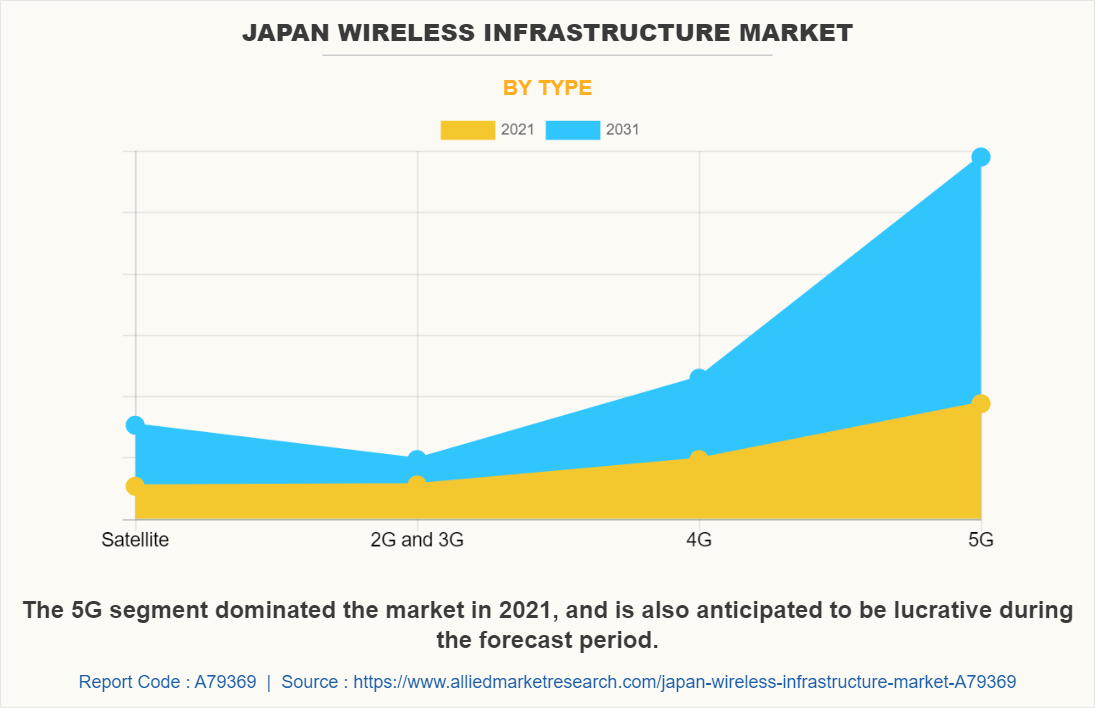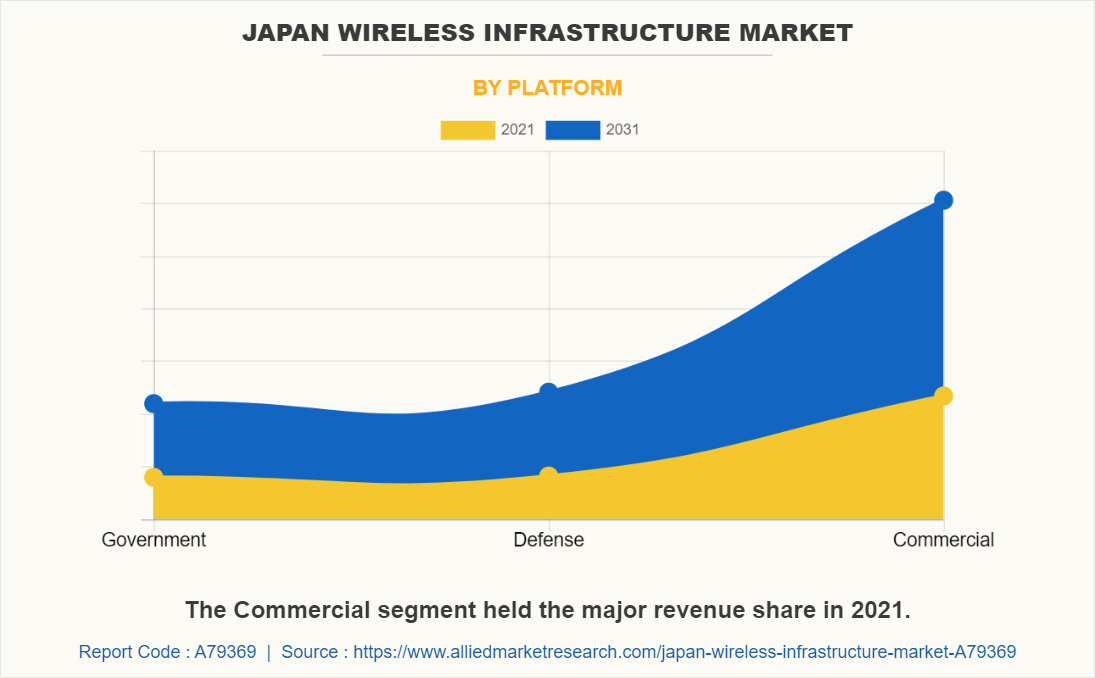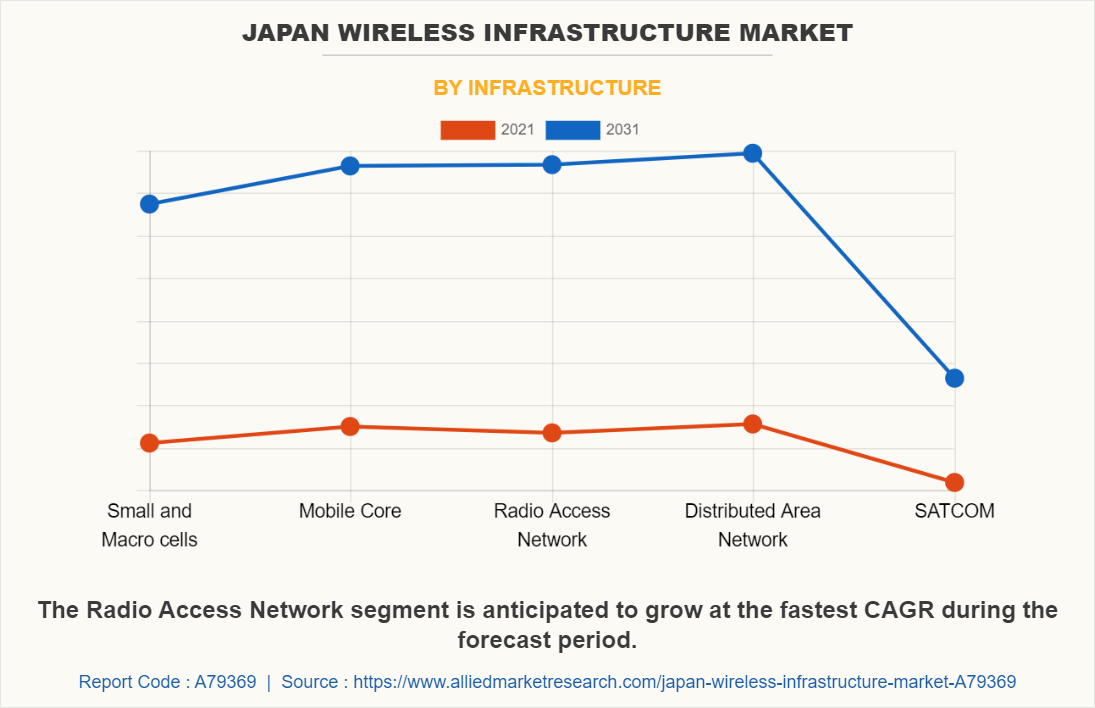Wireless infrastructure is the set of various communication assets, connectivity standards and connectivity solutions which combine in operations to give users with wireless networks. This network majorly focuses more on developing the whole connectivity and connection performance, while off-putting the need for wire connections among different devices and components.
The Japan wireless infrastructure market is expected to experience promising growth with increase in demand for 5G and IoT-based services along with advancements in wireless communication technologies. The factors responsible for market growth are technological advancements, increase in adoption of cloud-based technologies, and the potential to address the demand for broadband services.

The demand for wireless infrastructure is driven primarily by an increase in demand for high-speed internet services, technological advancements in wireless communication, and surge in market demand for 5G and IoT-based services. Moreover, government initiatives to introduce new technologies and support for the industry are likely to positively impact infrastructure growth. Increase in demand for wireless communication solutions, such as LTE, Wi-Fi, and LTE-advanced from MNOs & ISPs, is expected to accelerate market growth. Further, venture capital funding and favorable taxation policies are anticipated to drive market expansion.

On the other hand, high costs associated with setting up and maintaining telecom infrastructure are expected to hinder market growth. Moreover, tight security concerns, disputes over spectrum usage, and penalties imposed by governments and regulators on MNOs are expected to restrict market growth.

The demand for wireless infrastructure in Japan is expected to remain high due to increasing demand for high-speed data and internet services. Moreover, the introduction of 5G technology and IoT-based services is further likely to boost the demand for wireless infrastructure solutions. Moreover, the Government of Japan plans to introduce new regulations and policies to improve the telecommunications environment in the country. This is expected to provide favorable opportunities for the expansion of the wireless infrastructure market in Japan.

The Japan wireless infrastructure market is segmented into type, platform, and infrastructure. On the basis of type, the market is classified into satellite, 2G and 3G, 4G, and 5G. On the basis of platform, the market is categorized into government, defense, and commercial. On the basis of infrastructure, the market is divided into small and macro cells, mobile core, radio access network, distributed area network, and SATCOM.
Japan is the second largest telecommunications market in the world, and the demand for advanced wireless infrastructure solutions is expected to remain high due to increase in adoption of 4G and 5G technologies. Key players operating in the market are NTT DoCoMo, KDDI, SoftBank, Rakuten Mobile, NEC Corporation, Fujitsu, Hitachi, Mitsubishi Electric, Sony Corporation, and NTT Communications.
Key players in the Japanese wireless infrastructure have adopted new strategies such as developing new products & services, partnership, and acquisition.
The Government of Japan has imposed a number of regulations and standards on the wireless industry. These include spectrum usage rules, the Telecommunications Business Law, and the Cross-Industry Corporation Telecommunications Promotion Law. In addition, the government provides incentives for R&D and market development of wireless infrastructure solutions.
Key Benefits For Stakeholders
- Enable informed decision-making process and offer market analysis based on the current market situation and estimated future trends.
- Analyze the key strategies adopted by major market players in Japan wireless infrastructure market.
- Assess and rank the top factors that are expected to affect the growth of Japan wireless infrastructure market.
- Top Player positioning provides a clear understanding of the present position of market players.
- Detailed analysis of the Japan wireless infrastructure market segmentation assists to determine the prevailing market opportunities.
- Identify key investment pockets for various offerings in the market.
Japan Wireless Infrastructure Market Report Highlights
| Aspects | Details |
| Forecast period | 2021 - 2031 |
| Report Pages | 75 |
| By Type |
|
| By Platform |
|
| By Infrastructure |
|
| Key Market Players | KDDI, Fujitsu, Sony Corporation, NTT Communications, NTT DoCoMo, Hitachi, Rakuten Mobile, NEC Corporation, SoftBank, Mitsubishi Electric |
The Japan Wireless Infrastructure Market is estimated to reach $21.3 billion by 2031
NTT DoCoMo, KDDI, SoftBank, Rakuten Mobile, NEC Corporation, Fujitsu, Hitachi, Mitsubishi Electric, Sony Corporation, NTT Communications are the leading players in Japan Wireless Infrastructure Market
1. Enable informed decision-making process and offer market analysis based on current market situation and estimated future trends.
2. Analyze the key strategies adopted by major market players in japan wireless infrastructure market.
3. Assess and rank the top factors that are expected to affect the growth of japan wireless infrastructure market.
4. Top Player positioning provides a clear understanding of the present position of market players.
5. Detailed analysis of the japan wireless infrastructure market segmentation assists to determine the prevailing market opportunities.
6. Identify key investment pockets for various offerings in the market.
Japan Wireless Infrastructure Market is classified as by type, by platform, by infrastructure
Loading Table Of Content...
Loading Research Methodology...


